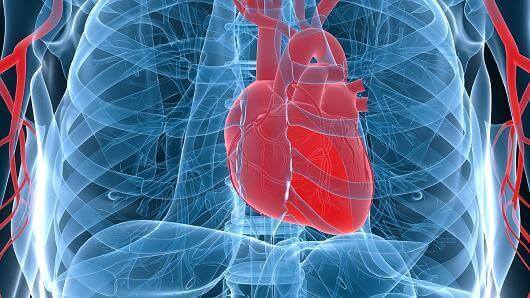The heart is one of the main organs of the body whose functioning guarantees the life of the person. It is considered the main organ of the circulatory system.
Its main function is to supply blood to each of the organs of the body. The heart located in the thoracic cavity is a hollow-type muscle with a pyramidal shape. It can weigh approximately 270 grams in an adult human being and its size resembles that of a closed fist.
This organ is divided into 4 parts: two upper parts called the atria and two lower parts called the ventricles. The pumping movement through which the blood enters and exits is called: systole and diastole.

Characteristics Of Heart
1. Location
It is located between the lungs in the center of the thorax and presents a slight inclination towards the left side of the human body.
2. Function principal
The heart provides oxygen and nutrients to the cells throughout the body. In order to fulfill this great function, it must beat more than 100,000 times per day.
3. Cavities
The heart is divided into 4 cavities: two upper ones called atria and two lower ones called ventricles. The atria are responsible for receiving the blood that comes from the organs throughout the body while the ventricles send blood to the rest of the body. As for power, the left ventricle has the greatest amount of force.
4. Valves
The heart also has valves that prevent the blood from returning or taking the wrong path (back) to the heart.
5. Pericardium, myocardium and endocardium
The heart is covered by a bag called pericardium that fulfills the function of protecting the heart. The outer layer of the pericardium is called the serous pericardium, while the inner layer (which protects valves and chambers) is called the endocardium. In the center of the heart between the pericardium and the endocardium is the myocardium, a muscular tissue with a striated appearance.
6. Coronary arteries
The heart needs blood for its functioning, but the blood that passes through it and is pumped to the whole body, transits too quickly. For this reason, the heart requires specific arteries, called coronary arteries.
7. Sinus node
Within the right atrium is what is known as a heart pacemaker. Its function is to stabilize the heartbeat. This node indicates to the heart when it should accelerate the pumping (product of a run or against the performance of a sport) or that the speed of the beats decreases while the body is at rest or sleeping.
8. Travel of blood with little oxygen flow
Each half of the heart works as an independent pump. The right half is responsible for the return of blood lacking oxygen that will travel to the lungs and then be removed from the body.
These cavities receive blood from the vena cava. The blood then passes from the left atrium through the valve to the left ventricle and out of the heart through the pulmonary artery.
9. Travel of blood with a lot of oxygen
Blood with more oxygen reaches the left atrium through the pulmonary veins. The passage of blood from the left atrium to the left ventricle is regulated through the valves.
It is important to mention that the walls of the left ventricle are 3 times larger than the right ventricle. This is due to the fact that it has to boost the blood with more energy so that it leaves the oxygen-laden heart and reaches all the organs of the body.
10. Capacity
As explained above, the heart has the main function of pumping oxygen and nutrients to the organs of the body. The upper cavities (atria) have a capacity of 50 ml of blood. The lower cavities (ventricles) have a somewhat higher capacity: 60 ml of blood. The whole heart can pump up to 7,000 ml of blood per day.